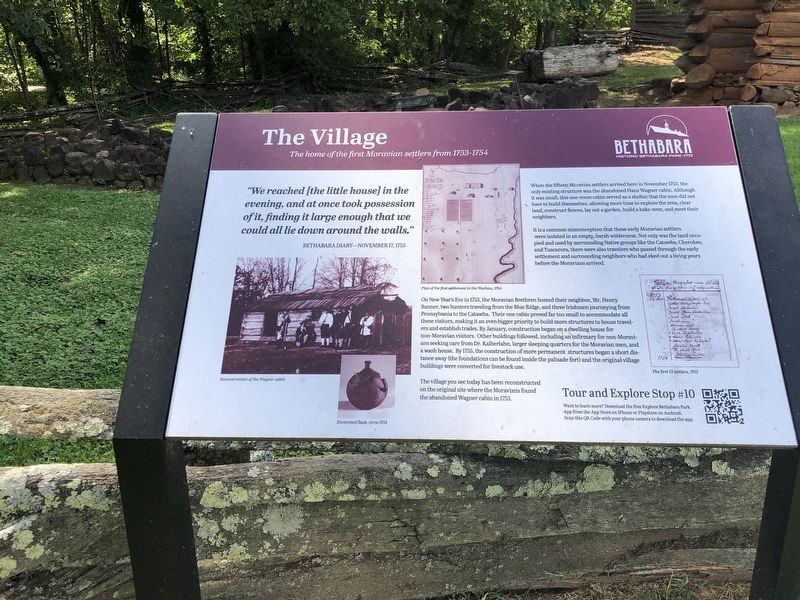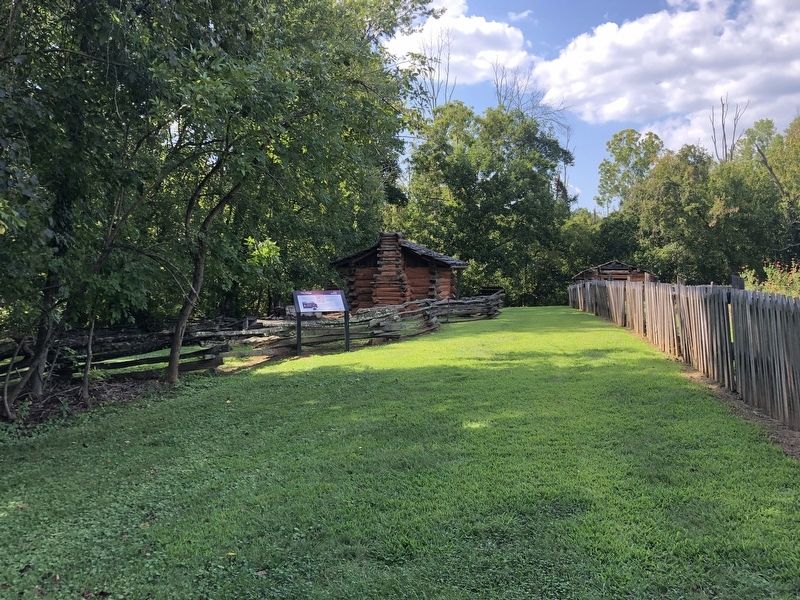Oldtown in Winston-Salem in Forsyth County, North Carolina — The American South (South Atlantic)
The Village
The home of the first Moravian settlers from 1753-1754
When the fifteen Moravian settlers arrived here in November 1753, the only existing structure was the abandoned Hans Wagner cabin. Although it was small, this one room cabin served as a shelter that the men did not have to build themselves, allowing more time to explore the area, clear land, construct fences, lay out a garden, build a bake oven, and meet their neighbors.
It is a common misconception that these early Moravian settlers were isolated in an empty, harsh wilderness. Not only was the land occupied and used by surrounding Native groups like the Catawba, Cherokee and Tuscarora, there were also travelers who passed through the early settlement and surrounding neighbors who had eked out a living years before the Moravians arrived.
On New Year's Eve in 1753, the Moravian Brethren hosted their neighbor, Mr. Henry Banner, two hunters traveling from the Blue Ridge, and there Irishmen journeying from Pennsylvania to the Catawba. Their one cabin proved far too small to accommodate all these visitors, making it an even bigger priority to build more structures to house travelers and establish trades. By January, construction began on a dwelling house for non-Moravian visitors. Other buildings followed, including an infirmary for non Moravians seeking care from Dre. Kalberlahn, larger sleeping quarters for the Moravian men, and a wash house. By 1755, the construction of more permanent structures began a short distance away (the foundations can be found inside the palisade fort) and the original village buildings were converted for livestock use.
The village you see today has been reconstructed on the original site where the Moravians found the abandoned Wagner cabin in 1753.
[Captions (left to right)]
• Reconstruction of the Wagner cabin.
• Excavated flask, circa 1753.
• The first 15 settlers, 1753.
Erected by Historic Bethabara Park. (Marker Number 10.)
Topics. This historical marker is listed in this topic list: Settlements & Settlers. A significant historical date for this entry is November 17, 1753.
Location. 36° 9.348′ N, 80° 17.975′ W. Marker is in Winston-Salem, North Carolina, in Forsyth County. It is in Oldtown. Marker can be reached from Bethabara Trail, 0.1 miles south of Old Town Drive, on the left when traveling south. Touch for map. Marker is at or near this postal address: 2200 Bethabara Rd, Winston Salem NC 27106, United States of America. Touch for directions.
Other nearby markers. At least 8 other markers are within walking distance of this marker. Bethabara Tavern 1757 (a few steps from this marker); Tavern Well 1763 (within shouting distance of this marker); Sleeping Hall 1754 (within shouting distance of this marker); Dwelling House/Cow House 1754 (within shouting distance of this marker); Community Garden 1759 (within shouting distance of this marker); Historic Bethabara Park 1753 (within shouting distance of this marker); Hans Wagner Cabin 1752 (within shouting distance of this marker); Medical Gardens 1761 (within shouting distance of this marker).
Also see . . . A History of Bethabara, North Carolina. The first settlers arrived in November of 1753, a group of eleven single men selected to provide the necessary skills for establishing a new community. Four others accompanied them on the journey but returned to Pennsylvania soon after. Additional settlers arrived beginning in 1754 and 1755, including the first women. The first community established was Bethabara, initially a stockaded fort protecting the neighboring farms. (J.D. Lewis, Carolana.com) (Submitted on October 17, 2023, by Duane and Tracy Marsteller of Murfreesboro, Tennessee.)
Credits. This page was last revised on October 17, 2023. It was originally submitted on October 5, 2023, by Duane and Tracy Marsteller of Murfreesboro, Tennessee. This page has been viewed 54 times since then and 7 times this year. Photos: 1, 2. submitted on October 5, 2023, by Duane and Tracy Marsteller of Murfreesboro, Tennessee.

